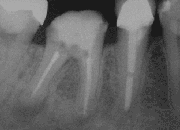Definition and Purpose of Apicoectomy
- Apicoectomy is a surgical procedure in endodontics.
- It involves the removal of the root tip and preparation of a root end cavity.
- The cavity is filled with a biocompatible material.
- Apicoectomy is performed when conventional root canal therapy fails.
- It is an alternative to tooth extraction followed by prosthetic replacement.
Materials Used for Root-End Filling
- The materials used for root-end filling must provide a good seal.
- They should be biocompatible and stable at body temperature.
- Radio-opacity is important for easy identification on radiographs.
- Commonly used materials include amalgam, composite resin, and mineral trioxide aggregate (MTA).
- Modified versions of zinc oxide eugenol cement (ZOE) are also used.
Success Rates of Apicoectomy
- Reported success rates for apicoectomy vary widely.
- A meta-analysis indicated an overall success rate of 85-95% using modern techniques.
- Another systematic review suggested success rates of 77.8% at 2-4 years, 71.8% at 4-6 years, and 62.9% at 6+ years.
- The likelihood of success is affected by various factors.
- Correctly performed apicoectomy can prevent tooth extraction.
Benefits of Mineral Trioxide Aggregate (MTA)
- MTA is a popular root-end filling material.
- It absorbs water to form a colloidal gel that solidifies over time.
- MTA creates a bactericidal environment and stimulates bone production.
- It has shown generally high success rates.
- MTA is beneficial for its properties and clinical outcomes.
References
- Endodontic Microsurgery. Compendium of Continuing Education in Dentistry, June 2007.
- Endodontists Guide to CDT 2017 (PDF). American Association of Endodontists, 2017.
- Analysis of the Cause of Failure in Nonsurgical Endodontic Treatment by Microscopic Inspection during Endodontic Microsurgery. Journal of Endodontics, 2011.
- Considerations in the selection of a root-end filling material. Oral Surgery, Oral Medicine, Oral Pathology, Oral Radiology, and Endodontology, 1999.
- Root end filling materials - A review (PDF). Endodontology, 2003.
A root end surgery, also known as apicoectomy (apico- + -ectomy), apicectomy (apic- + -ectomy), retrograde root canal treatment (c.f. orthograde root canal treatment) or root-end filling, is an endodontic surgical procedure whereby a tooth's root tip is removed and a root end cavity is prepared and filled with a biocompatible material. It is an example of a periradicular surgery.
| Apicoectomy | |
|---|---|
 X-Ray of a tooth after root end surgery | |
| ICD-9-CM | 23.7 |
| MeSH | D001047 |
An apicoectomy is necessary when conventional root canal therapy has failed and a re-treatment was already unsuccessful or is not advised. Removal of the root tip is indicated to remove the entire apical delta ensuring no uncleaned missed anatomy. The only alternative may be extraction followed by prosthetic replacement with a denture, dental bridge or dental implant.
State-of-the-art procedures make use of microsurgical endodontic techniques, such as a dental operating microscope, micro instruments, ultrasonic preparation tips and calcium-silicate based filling materials.
In an apicoectomy, only the tip of the root is removed. This is in contrast to root resection, where an entire root is removed, and hemisection, where a root together with its overlying portion of the crown are separated the rest of the tooth and optionally removed.
apico- + -ectomy
apicoectomy (countable and uncountable, plural apicoectomies)